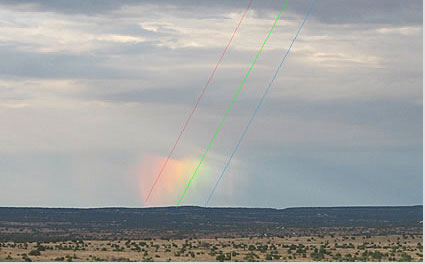Rainbow patches in the sky
Rainbow Patches in the Sky: A Phenomenon Worth Noticing
Have you ever looked up at the sky and noticed peculiar patches of color that resemble rainbows but don't quite fit the traditional shape? These mesmerizing phenomena, known as rainbow patches, can captivate our attention and leave us wondering about their origins. In this article, we will delve into the intriguing world of rainbow patches in the sky and explore the science behind these unique atmospheric optics displays.
Rainbows are typically associated with rain showers, where sunlight interacts with raindrops to create a beautiful arc of colors. However, rainbow patches differ from traditional rainbows in shape and formation. Instead of a complete arc, they appear as irregular patches or streaks of colors against the backdrop of the sky. One such example was captured by Jodi Moses in Taylor, Arizona, as she looked east towards New Mexico on a late afternoon in July 2006.
To understand why these odd-colored patches manifest in the sky, we must consider the positioning of the sun and the antisolar point, which is directly opposite the sun. In the case of the photographed rainbow patch, the sun was approximately 30° high, with the antisolar point positioned to the right of the image. Typically, if there were rain nearby, a complete rainbow would have formed along the colored lines. However, in this instance, the rain shower was distant and falling at an angle.
When rain falls at an angle that aligns with the sun's position, it creates a fascinating interplay of light and water droplets. This alignment forms what is known as the "rainbow cone," where raindrops become illuminated with rainbow colors. In the case of the observed patch, the rain was at just the right angle to the sun, causing it to light up in an array of vibrant hues. The vertical appearance of the patch can be attributed to the near-vertical streaks of rain that guide the viewer's eye.
Rainbow patches serve as a reminder of the intricate relationship between sunlight, rain, and our atmosphere. While traditional rainbows are more commonly observed, these patches offer a glimpse into the dynamic nature of atmospheric optics. They showcase how slight variations in weather conditions and the position of the sun can give rise to unique and awe-inspiring displays.
To further appreciate the beauty of rainbow patches, it's essential to consider the broader context of atmospheric optics. These optical phenomena encompass a wide range of natural occurrences that involve the interaction of light with various atmospheric elements. From halos and sundogs to iridescent clouds and crepuscular rays, the world of atmospheric optics is filled with captivating wonders.
Understanding the science behind rainbow patches requires an appreciation for the behavior of light and its interaction with water droplets. When sunlight enters a raindrop, it undergoes refraction, causing the different wavelengths of light to bend at varying angles. This dispersion of light then leads to the formation of a rainbow, with each color corresponding to a specific wavelength.
In the case of rainbow patches, the scattered raindrops create an irregular distribution of colors, resulting in the patch-like appearance. The precise angle at which the rain falls in relation to the sun determines which areas are illuminated with rainbow hues. It is this interplay between sunlight, raindrops, and atmospheric conditions that gives rise to these fascinating phenomena.
Rainbow patches in the sky are not only visually captivating but also serve as a reminder of the complexity and beauty of our natural world. They invite us to marvel at the wonders of atmospheric optics and ponder the delicate balance of factors necessary for their formation. So, next time you find yourself gazing at the sky, keep an eye out for these enchanting patches of color that add a touch of magic to our everyday surroundings.

Sky Colours, Arizona Sometimes coloured patches appear in the sky that are unlike 'ordinary' rainbows in shape. Jodi Moses caught this from Taylor Arizona looking East towards New Mexico late afternoon in July '06. ©Jodi Moses, shown with permission.

Why an odd coloured patch?
The sun was ~30° high and the antisolar point, opposite the sun, was to the right of the image. If there had been rain nearby, a whole rainbow would have been seen roughly along the coloured lines. Instead, the rain shower was far away and falling in slanting streaks. Where the rain was at the correct angle to the sun (i.e on the rainbow cone) it lit up in rainbow colours. The patch has a vertical appearance because the eye is guided by the near vertical rain streaks.
Note: this article has been automatically converted from the old site and may not appear as intended. You can find the original article here.
Reference Atmospheric Optics
If you use any of the definitions, information, or data presented on Atmospheric Optics, please copy the link or reference below to properly credit us as the reference source. Thank you!
-
<a href="https://atoptics.co.uk/blog/rainbow-patches-in-the-sky/">Rainbow patches in the sky</a>
-
"Rainbow patches in the sky". Atmospheric Optics. Accessed on November 23, 2024. https://atoptics.co.uk/blog/rainbow-patches-in-the-sky/.
-
"Rainbow patches in the sky". Atmospheric Optics, https://atoptics.co.uk/blog/rainbow-patches-in-the-sky/. Accessed 23 November, 2024
-
Rainbow patches in the sky. Atmospheric Optics. Retrieved from https://atoptics.co.uk/blog/rainbow-patches-in-the-sky/.